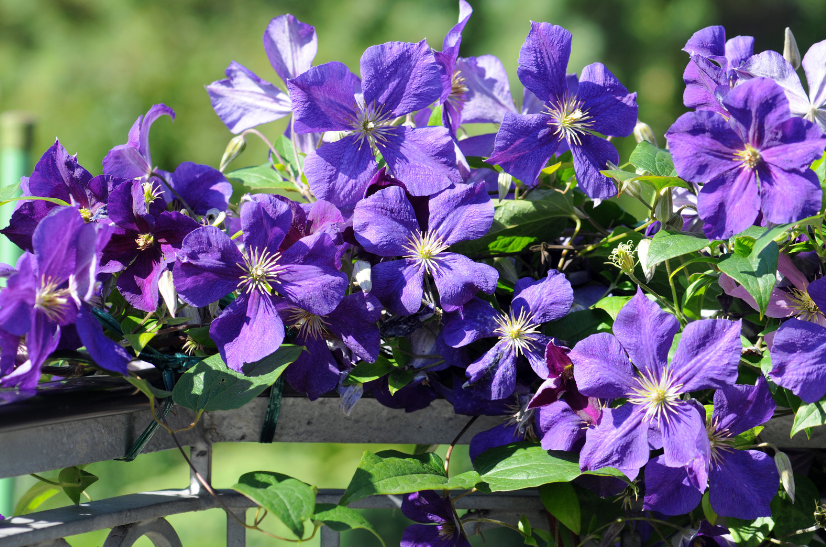
Virgin’s bower, Clematis virginiana, is a native perennial vine with very conspicuous fragrant flowers.
Found in the piedmont and mountains of North Carolina as well as several eastern and central states, this prolifically spreading vine can be found in numerous sites along streams, woodland openings, margins of roads, and atop fence rows.
Although a potential candidate for wild gardens, this vine may require substantial attention to control undesirable growth, which could crowd out other species.
For this reason, a virgin bower is probably not desirable for gardeners with limited space or insufficient time to control a spreading vine.
Also, since a virgin’s bower has the potential to cause severe skin irritation, caution must be used in dealing with this vine.
How to Grow Virgin’s Bower
Clematis Virgin’s Bower is ideal for naturalizing wooded or wilder areas of your garden.
It grows readily along manmade structures such as fences and trellises and is fairly deer-resistant.
White flowers attract hummingbirds, butterflies, and bees, and dense green foliage attracts birds. Mammals can consume no part of the plant.
Virgin’s Bower vines thrive in a rich, fertile loamy, or silty soil that is moist to above average.
Partial shade is best for growing it. The care of Virgin’s Bower is much easier than other types of clematis, and it has no reported insect or disease problems.
The care of Virgin’s Bower is much easier than other types of clematis, and it has no reported insect or disease problems.
Is Virgin’s Bower Clematis an invasive plant?
Virgin’s Bower is a fast-growing clematis that can spread aggressively throughout a garden.
By wind-dispersed seeds and asexual suckers, it propagates easily. In the garden setting, these are easily controlled:
Virgin’s bower is dioecious, unlike other types of clematis. Plants must be both male and female to produce seeds.
Purchase one Virgin’s Bower vine and propagate it asexually to prevent seeds from forming.
Clematis Virgin’s Bower blooms only on new wood, so radical pruning will not affect flower production.
It can be trimmed back to 8 to 12 inches (20-31 cm.) above the soil line in late fall or early spring to control its shape.
The vigorous growth of this clematis is not considered harmful to trees, even though it must be controlled.
Controlled, they can make an excellent addition to a naturalized garden.
White blossoms add a delicate charm to any fall garden bed.
Other Clematis Worth Planting
-
Clematis Alpina
Grows 6 to 23 feet (2 to 7 meters) each season. Flowers early spring, with numerous 2-inch bell-shaped blooms. It prefers full sun but tolerates semi-shade. Can be pruned or left alone, as desired.
- Some recommended names: are Francis Rivis (light blue), Ruby (rosy red), and Gravetye Form (white).
-
Clematis macropetala
Exact details as for Alpina.
- Some recommended names: Maidwell Hall (blue), Markham Pink (pink), White Moth (white).
-
Clematis viticella:
Grows 6 to 16 feet (2 to 5 meters) each season. Flowers late spring and summer, with many 3-to-5-inch-wide star-shaped blooms in a wide range of colors and stripes. Full sun preferred. Flowers on new stems, so prune back old wood as low as desired.
- Some recommended names: Huldine (white); Ville de Lyons; Rouge Cardinale; Ernest Markham; Royal Velours and Niobe (all red); Pink Chiffon; Comtesse de Bouchaud, sometimes listed as Bouchard (pink); Jackmanii, Etoile Violette and Elsa Spath (all blue/ purple).
-
Clematis Orientalis
Grows 6 to 16 feet each season. Flowers late summer, with many 2-inch yellow bell-shaped blooms. Full sun to semi-shade.
- Some recommended names: Bill MacKenzie, Stans. Clematis recta var. purpurea: Grows 3 to 4 feet high (1 to 1.3 meters). Flowers through summer, with small blooms all over. Full sun to semi-shade. Prune to the ground in fall.
Plant Profile
- NAME: Clematis montana rubens
- AKA: Virgin’s bower
- TYPE: Perennial woody vine
- FAMILY: Ranunculaceae (buttercup family); related to black cohosh, hellebores, delphinium, love-in-a-mist, bloodroot
- VITAL STATS: Can grow to 30 feet tall and 6 to 10 feet wide
- NATIVE LAND: Himalaya Mountains, China
- BLOSSOM TIME: Early summer
- BEST FEATURES: Vigorous climber with purplish-tinged leaves (can easily hide an ugly fence or side of a house), a multitude of 2- to 3-inch, fragrant pink flowers (sometimes in clusters) cover the plant. Like many clematises, attractive whorled seedheads follow the bloom, remaining well into autumn.
- LIKES: Well-drained, fertile, humusy soil; full sun to partial shade
- SWORN ENEMIES: Fungal spots, dieback, rust, powdery mildew, aphids
- PLANT PARTNERS: Plant with a late-blooming clematis, such as sweet autumn clematis (Clematis ternifolia), for multi-season interest
- TLC: If pruning is necessary to keep it within bounds, prune immediately after it blooms.

























